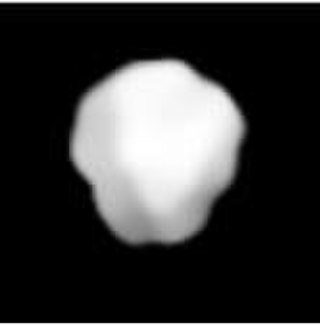11 Parthenope
Main-belt asteroid From Wikipedia, the free encyclopedia
11 Parthenope (/pɑːrˈθɛnəpi/ parth-EN-ə-pee) is a large, bright main-belt asteroid.
 Deconvolved VLT-SPHERE image of Parthenope | |
| Discovery | |
|---|---|
| Discovered by | Annibale de Gasparis |
| Discovery site | Naples Obs. |
| Discovery date | 11 May 1850 |
| Designations | |
| (11) Parthenope | |
| Pronunciation | /pɑːrˈθɛnəpi/ parth-EN-ə-pee[1] |
Named after | Parthenopē |
| Main belt | |
| Adjectives | Parthenopean (/ˌpɑːrθənəˈpiːən/ PARTH-ə-nə-PEE-ən) Parthenopian (/ˌpɑːrθəˈnoʊpiən/ PARTH-ə-NOH-pee-ən)[2] |
| Symbol | or (historical) |
| Orbital characteristics[3] | |
| Epoch 17.0 October 2024 (JD 2460600.5) | |
| Uncertainty parameter 0 | |
| Observation arc | 63626 days (174.20 yr) |
| Aphelion | 2.69732 AU (403.513 Gm) |
| Perihelion | 2.20942 AU (330.525 Gm) |
| 2.45337 AU (367.019 Gm) | |
| Eccentricity | 0.09943 |
| 3.84 yr (1403.6 d) | |
Average orbital speed | 19.02 km/s |
| 71.503° | |
| 0° 15m 23.342s / day | |
| Inclination | 4.63153° |
| 125.506° | |
| 2024-Jan-12 | |
| 196.071° | |
| Earth MOID | 1.197 AU (179.1 Gm) |
| Jupiter MOID | 2.54059 AU (380.067 Gm) |
| TJupiter | 3.483 |
| Physical characteristics | |
| Dimensions | 156 × 152 × 138 ± 6 km[4] |
| 149±2 km[4] 142.887±1.008 km[3] | |
| Flattening | 0.12[a] |
| Mass | (5.5±0.4)×1018 kg[4] 6.15×1018 kg[5] |
Mean density | 3.20±0.27 g/cm3[4] 3.28±0.20 g/cm3[5] |
Equatorial surface gravity | 0.0578 m/s2 |
Equatorial escape velocity | 0.0941 km/s |
| 13.7204 h (0.57168 d)[3] 13.72204±0.00001 h[4] | |
| 73°[4] | |
Pole ecliptic latitude | 17°±4°[4] |
Pole ecliptic longitude | 312°±2°[4] |
| 0.187 (calculated)[4] 0.191±0.021[3] | |
| Temperature | ~174 K |
| S-type asteroid[3] | |
| 8.68[6] to 12.16 | |
| 6.73[3] 6.55[4] | |
| 0.178" to 0.057" | |
Parthenope was discovered by Annibale de Gasparis on 11 May 1850, the second of his nine asteroid discoveries. It was named after Parthenopē, one of the Sirens in Greek mythology, said to have founded the city of Naples. De Gasparis "used his utmost endeavours to realise a 'Parthenope' in the heavens, such being the name suggested by Sir John Herschel on the occasion of the discovery of Hygiea in 1849".[7] Two symbols were proposed for Parthenope: a fish and a star (in the pipeline for Unicode 17.0 as U+1CEC4 ![]() ) while such symbols were still in use, and later a lyre (in the pipeline for Unicode 17.0 as U+1F77A
) while such symbols were still in use, and later a lyre (in the pipeline for Unicode 17.0 as U+1F77A ![]() ) in lists of symbols. Both are obsolete.[8][9]
) in lists of symbols. Both are obsolete.[8][9]
There have been two observed Parthenopian occultations, on 13 February 1987, and 28 April 2006.
On 6 August 2008, during a perihelic opposition, Parthenope had an apparent magnitude of 8.8.
In 1988 a search for satellites or dust orbiting this asteroid was performed using the UH88 telescope at the Mauna Kea Observatories, but the effort came up empty.[10]
Based upon a light curve that was generated from photometric observations of this asteroid at Pulkovo Observatory, it has a rotation period of 13.722 ± 0.001 hours and varies in brightness by 0.10 ± 0.0s in magnitude. The light curve displays three maxima and minima per cycle.[11] The JPL Small-Body Database lists a rotation period of 13.7204 hours.[3]
Mass
In 2007, Baer and Chesley calculated a higher mass and density for Parthenope based on perturbations by the 90 km asteroid 17 Thetis. Baer and Chesley calculated a mass of 6.3×1018 kg with a density of 3.3 g/cm3.[12] 2008 estimates by Baer suggest a mass of 6.15×1018 kg.[5] The 1997 and 2001 estimates by Viateau and Rapaport were closer to 5×1018 kg with a density of 2.7 g/cm3.[12]
See also
Notes
- Flattening derived from the maximum aspect ratio (c/a): , where (c/a) = 0.88±0.05.[4]
References
External links
Wikiwand - on
Seamless Wikipedia browsing. On steroids.

